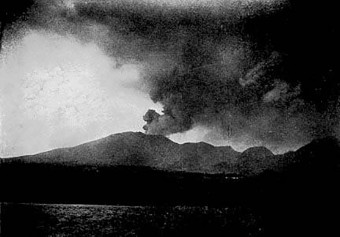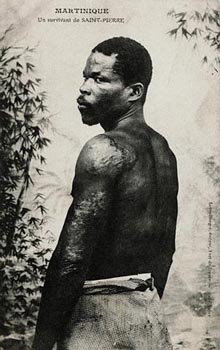This Day in History: May 8th- The Eruption of Mount Pelée
This Day In History: May 8, 1902
 “I know nothing about Mount Pelée, but if Vesuvius were looking the way your volcano looks this morning, I’d get out of Naples.” – Marino Leboffe, Captain of the Italian freighter “Orsolina” 5/2/02
“I know nothing about Mount Pelée, but if Vesuvius were looking the way your volcano looks this morning, I’d get out of Naples.” – Marino Leboffe, Captain of the Italian freighter “Orsolina” 5/2/02
On May 8, 1902 Mt. Pelée on the Caribbean island of Martinique unleashed an eruption that killed approximately 30,000 people, the highest death toll of any volcanic activity in the twentieth century. The volcano had been giving ominous warning signs for days, but the government did not want anything to interfere with its upcoming election.
By late April, minor explosions were occurring near the summit of Mt. Pelée, and then the ground beneath St. Pierre was rocked by tremors of increasing intensity. The town was showered in ash, and then smothered in a fog of sulfurous gas.
Conditioned worsened when not only St. Pierre but also the out-lying areas were swamped by the insects and snakes driven out from the slopes of Mt. Pelée due to the falling ash and tremors. Farm animals and pets were particularly helpless to the attacks from the biting insects and snakes. An estimated 200 animals, and sadly 50 humans, lost their lives due to poisonous snake bites before the volcano even erupted.
As the eruptions near the summit worsened, the water temperature in the crater’s lake was near boiling. When the crater’s rim gave way on May 5, the resulting scalding stream of rapidly running water overran a rum distillery north of St. Pierre, killing 23 people. The lahar raced for the sea where it caused a tsunami that flooded St. Pierre’s low-lying areas. People began to pack up their bags.
Unbelievably, over the next few days the government convinced the many panicky citizens considering leaving St. Pierre to stay put. The governor released a report stating that “there is nothing in the activity of Mt. Pelée that warrants a departure from St. Pierre” and adding “the safety of St. Pierre is completely assured.”
The election to keep the ruling party in power had to go on at all costs. Troops forcibly turned back those who tried to leave, sentencing thousands of people to certain death.
As the residents of St. Pierre were heading for church to celebrate Ascension Day on May 8, a monstrous wave of red-hot gas, rock, and ash burst headlong down the south side of Mt. Pelée at the incredible speed of 100 mph. It took less than a minute to reach the town, obliterating everything in its path and cremating most people where they stood.
Scientists believe the town was most likely decimated by a pyroclastic flow, a phenomenon that was unknown at the time. It’s common on convergent plate margins and is characterized by its particularly explosive nature and dangerous density currents. (Mt. St. Helens was another such example.)
St. Pierre was in flames for several days after the eruption.
 Only three people from St. Pierre were known to have survived the eruption. One was a young shoemaker named Léon Compère-Léandre who escaped into the neighboring village of Fonds-Saint-Denis. Another was Havivra Da Ifrile, a girl who hid in a cave in hopes of avoiding the blast, but was swept out to sea only to be miraculously rescued several days later.
Only three people from St. Pierre were known to have survived the eruption. One was a young shoemaker named Léon Compère-Léandre who escaped into the neighboring village of Fonds-Saint-Denis. Another was Havivra Da Ifrile, a girl who hid in a cave in hopes of avoiding the blast, but was swept out to sea only to be miraculously rescued several days later.
And finally there was the most well-known of the survivors, 25-year-old Louis-Auguste Cyparis, who survived the devastation in his prison cell. This was a solitary confinement cell partially underground and with bomb-proof walls. Notably, the cell also had no windows, with the only ventilation being a very small grate in the door. While he did suffer burns all over his body, with air temperature outside the building estimated to have reached just shy of 2,000 degrees Fahrenheit, the peak of the heat only lasted a very little while, so his cell offered him sufficient insulation, if only just. He also urinated on his shirt and stuffed it in the ventilation grate in an attempt to keep the heat and gases out. Cyparis was ultimately rescued from his cell four days after the eruption and P.T. Barnum added him to his human menagerie; he became known as “Samson of St. Pierre”, retelling his harrowing tale of surviving the eruption of Mt. Pelée for captivated audiences all over America.
If you liked this article, you might also enjoy our new popular podcast, The BrainFood Show (iTunes, Spotify, Google Play Music, Feed), as well as:
- 12 Interesting Volcano Facts
- 1816- The Year That Had No Summer
- How Things Become Petrified
- The Tunguska Event, a 1908 Explosion Estimated at 1000 Times More Powerful Than the Atomic Bomb Dropped on Hiroshima
- Where Did All the Neanderthals Go?
Bonus Fact:
- Pliny the Elder, the famed author, naturalist, philosopher, and commander, died trying to rescue people stranded on the shores after the eruption of Mt. Vesuvius, which destroyed Pompeii and Herculaneum. While attempting to sail his ship near the shore, burning cinders fell on the ship. Rather than turn around, as his helmsman suggested, Pliny reportedly stated “Fortune favors the brave! Steer to where Pomponianus is.” He landed safely and was able to rescue his friends and others on the shore. However, he never left that shore. Before they were able to set out again (they needed the winds to shift before they could safely leave), he died and ended up being left behind. It is thought he died of some sort of asthmatic attack or by some cardiovascular event, possibly brought on by the heavy fumes and heat from the volcano. His body was later retrieved three days later buried under pumice and it had no apparent external injuries. He was around 56 years old.
| Share the Knowledge! |
|





What a fascinating story! The eruption sounds like a natural equivalent of the devastation caused by the atomic bombs dropped on Hiroshima and Nagasaki.